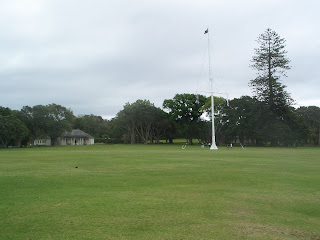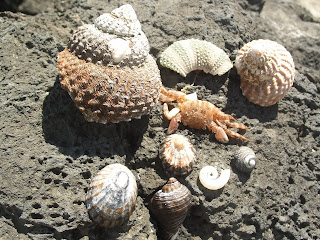
We've now returned from the Northland, having explored and enjoyed the beaches, the hiking and the history. The beaches of New York and New England where we spent our childhood are so boring compared to these, particularly the shells. We had a hard time not looking down all the time and getting as excited as little kids


at all the variety and color of them. Even the sand is interesting due to infusions of black basalt sand, creating interesting patterns. So this blog will have a slightly different approach and intersperse pictures from our beach walks

and also some of our hikes to high places and to waterfalls, while mainly talking about New Zealand history, which to a large extent began in the Northland.

The first white guy to reach New Zealand, in 1642, was Abel Tasman, who lends his name to the Tasman Sea between here and Australia (NZ newspapers often say "on the other side of the Tasman" as a long-winded way of saying Australia (and "Oz" as a short way))

and to Tasmania, that large island to the SE of Australia where Bugs Bunny's friend the Tasmanian Devil lives. He also grabbed the naming rights to New Zealand, and chose the name of a province in his Netherlands homeland.

He obviously didn't make the place inviting enough or easy enough to find, as the next visitor didn't make it until 127 years later, when Captain Cook dropped by in 1769.

For the next 70 years, a variety of non-Maori, or pakeha as they are called in NZ, came by, usually only for short visits to make a quick buck wiping out the seal and whale populations.

The main long-term visitors were missionaries, primarily Anglican but with a few Methodists thrown in, and they got to work creating English-Maori dictionaries and writing translations of the Bible and other religious works in Maori. The second-oldest surviving building in NZ is the mission house at Te Waimate shown here,



with its cozy study and an antique sampler on the wall -- the genuine one, with nice copies available for sale in the gift shop. The oldest surviving building in NZ is the Kemp House in the coastal town of Kerikeri, the frame building to the right in this picture.


It was built in 1821. It housed a missionary family and was reasonably comfortable inside, given where it was in this far-away land, as the photo of the bedroom shows.

By comparison, here is the outside and inside view of a reconstructed Maori home from that period.

Next door to the Kemp House was the Stone House, actually a store that was a Very Big Deal to the Maori, as it was a place they could get iron goods, such as these items shown for sale.
 It's the oldest stone structure in NZ, dating to 1832.
It's the oldest stone structure in NZ, dating to 1832. 
By 1839 there were perhaps 75,000 Maori in NZ plus about 2,000 pakeha staying more-or-less permanently, and maybe another 1,000 visiting at any time. The pakeha were almost all British. But the French had set up a Catholic mission in Russell, seen here from a nearby hill, including the obligatory printing press

being demonstrated in the next photo taken in Pompellier House, yet another 1830's building. It had a tannery out back which attracted rats, some of which were rediscovered in a fairly rigid posture

when the building was renovated a few years ago. Those darned papist Frenchmen were also starting to poke around elsewhere in NZ, something that always made 19th century Brits quite jumpy, and a fellow in London was about to establish a major new settlement in what ultimately became Wellington. The Colonial Office decided it was time to have some sort of British control over New Zealand.


Meanwhile the Maori were starting to think that might not be a bad idea. The end of the Napoleonic Wars 20 years earlier had put a ton of muskets on the world market, cheap. Add in some money made from trade with the Brits, and the Maori started buying firepower. The first one to hit on the idea in 1821, Hongi Heke,

pretty much slaughtered his enemies and evened up old scores, with a vengeance. It didn't take long for other tribes to start growing things asap to trade with unscrupulous merchants in order to buy their own muskets,

and the Musket Wars were in full swing. They were all Maori tribe vs. Maori tribe, and they were vicious, truly vicious -- a common estimate is that 20% of the Maori population was killed. The warfare had petered out by 1840 as all the tribes had pretty well armed themselves equally and developed good defensive tactics, but the fear of new violence was always there.

So on Feb. 5, 1840 a large number of Maori in the northern part of the North Island assembled in Waitangi in front of the home of a British official who had been asked to gin up a treaty. That's his house in the background, and the lawn where the Maori gathered. He and another fellow wrote something up with only very general direction from London, and local missionaries translated it into Maori. There were discussions all day between the officials and the Maori, with the missionaries acting as intermediaries to explain what this thing meant, then the tribes retired to another area to discuss it many more hours into the night. The next day most of them signed, and copies were subsequently taken around NZ and signed by many more of the tribes.

The Treaty of Waitangi, as it is called, is considered the birthing moment of NZ, and these grounds a major historical site. Next to the treaty house is this large marae, or traditional meeting place, usually for use by a specific tribe or subtribe, but in Waitangi dedicated to all Maori. That's Kupe on the top of the rafters, the legendary leader of the first Polynesian colonists who became the Maori,

and inside are gorgeous carvings from all the Maori tribes, one of them shown a few paragraphs up and another here. Also nearby is this war canoe built for the 1940 centennial celebration of the treaty and named Ngatokimatawhaorua, made from three enormous kauri trees (remember them from our last blog?).


Treaties, just like kids, grow up in unexpected ways, and change their appearance to others over time. This one was particularly challenging, as there were minor differences in the different copies signed, and even larger differences between the English and Maori versions. Maori did not exactly have a word for "sovereignty," for example, and the Maori word used by the missionaries has ambiguity galore.

Add in Anglo-Saxon attitudes toward other races as the 19th century continued and moved into the 20th, and pakeha New Zealand came to view the treaty as a quaint historical document, but not as a binding contract,never mind that it promised to respect "the full, exclusive, and undisturbed possession of [Maori] Lands and Estates, Forests, Fisheries, and other properties."

Then came the '60s and the civil rights movement in the US, anti-apartheid in South Africa, and independence movements all over the globe.

Pakeha New Zealand began to see some justice in the Maori view that the treaty was a binding contract, and one that New Zealand was in serious breach of as a nation. By 1975 the Waitangi Tribunal had been established to investigate Maori complaints, and in subsequent years it has been given increasing authority. It is now a Very Big Deal to all New Zealanders.

Much of this mirrors what America has also had to deal with, but New Zealand is not America, and its legal system and its voters have rejected the American view of the role of the judiciary as the ultimate arbiters of the constitution. There have been legal cases galore in the sorting out of the legacy of Waitangi,

but most of the change that has come, and it is profound, has been through administrative investigations by the Waitani Tribunal, which makes recommendations for settlement. Then the government and the Maori tribes and/or subtribes involved negotiate with that as a starting point, and reach a final binding agreement.

Several of these settlements have involved the transfer of money and/or assets of over $100 million each, and almost all have involved the issuance of an apology from the government. More significantly, Maori language is present much more in public places than it was 14 years ago when Louise was here before, and pakeha NZ seems much more aware of at least some aspects of the Maori view of life.

It hasn't all been smooth sailing, and New Zealand will be rectifying the injustices of a century of disregard for Waitangi for quite some time, but it has been (to these foreign observers anyway) a seemingly successful approach.

There will be unhappy folks for sure, as there are with almost any settlement (something Jeff remembers all too painfully from his decades as a litigator), but not as unhappy as they'd be without the settlements!

We hope the less-legally-inclined have at least been entertained by the photos in today's blog, including

this imaginary necklace of shells placed against a sweater -- aren't they gorgeous! (Click on the photo to enlarge it and see just how stunning they are, then hit the back key on your browser to return here) We're about to hit the road again, and have indeed decided it's not sufficiently safe to bike the North Island, at least some of the parts we're most interested in seeing.

We're bringing the bike to the other end of North Island by car first, where Wellington friends from our trip on the Volendam will store it in their garage. We'll then spend 3 weeks touring the North Island by car and on foot. A week before

Christmas we turn in the rental car and take off for 3 1/2 weeks in Australia, then finally start biking the South Island of New Zealand in mid-January. We hope to put up our next post in about 2 weeks. Talk to you then!


No comments:
Post a Comment